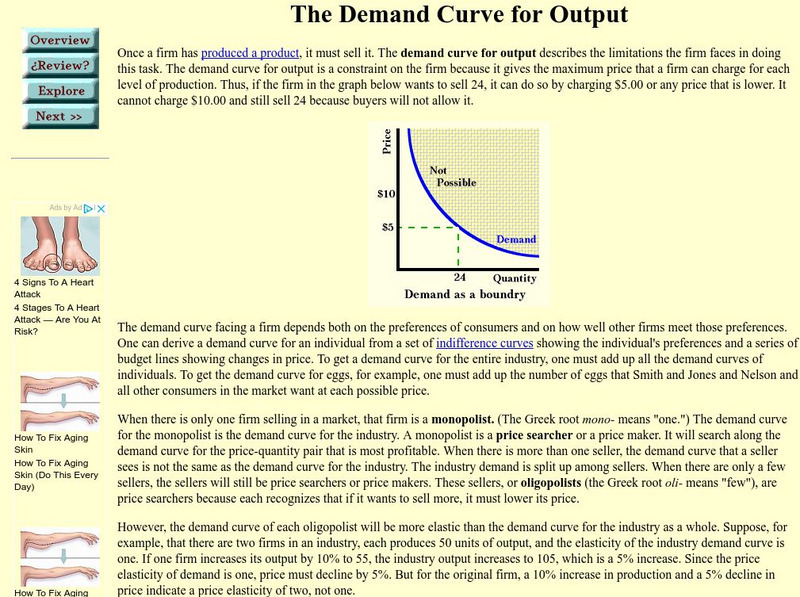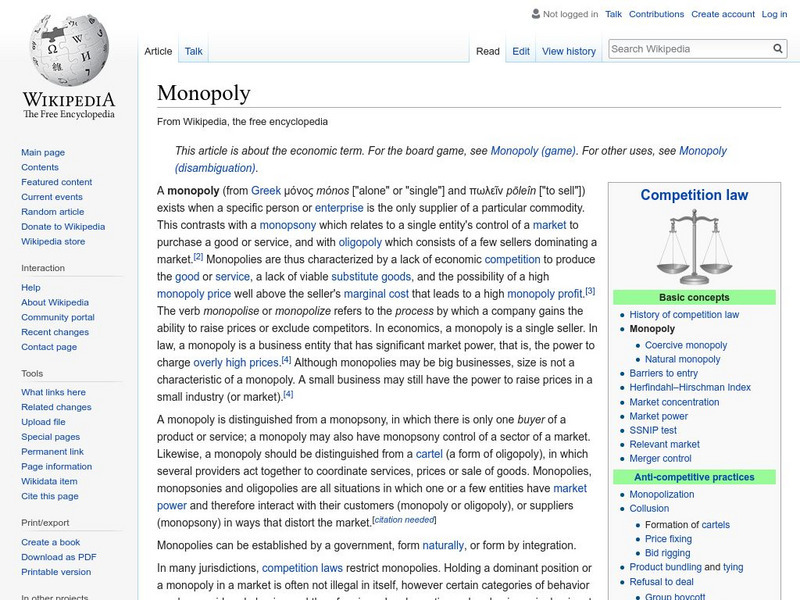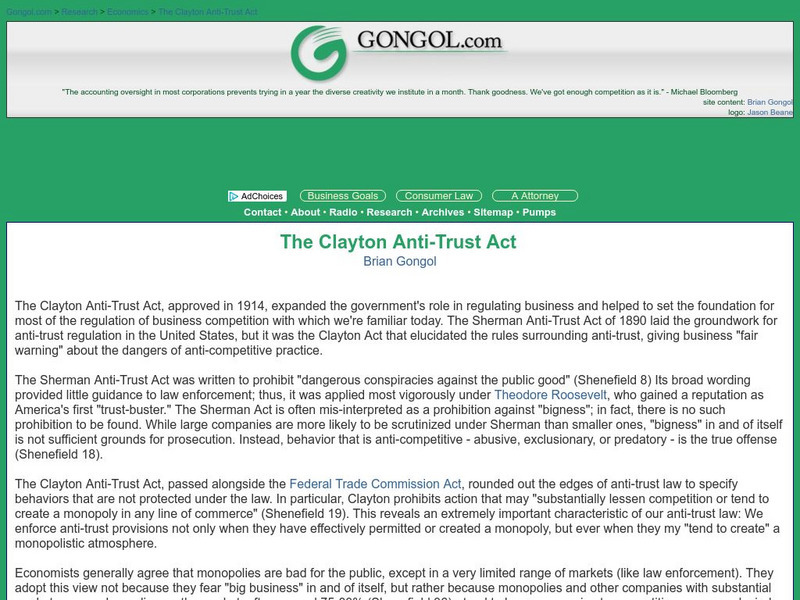Digital History
Digital History: Standard Oil on Trial [Pdf]
The anti-trust case against Standard Oil, based on the Sherman Antitrust Act, pitted the federal government against the largest corporation in the United States. Read the trial preparation information including the arguments of the...
Robert Schenk, PhD
Cyber Economics: The Demand Curve for Output
This site examines the relationship between a price taker and a price maker, and the market structure to which each might belong.
US National Archives
Nara: Teaching With Documents: Telephone and Light Patent Drawings
A lesson plan about Alexander Graham Bell's patent for the telephone and Thomas Edison's patent for the electric lamp. Contains good background information and historically pertinent documents. It also discusses the role corporations...
Alberta Online Encyclopedia
Alberta Online Encyclopedia: The Hudson's Bay Company's Monopoly (1821 1850)
Learn about the Hudson's Bay Company monopoly of the fur trade in Western Canada from 1821-1850. This Alberta Online Encyclopedia article has pictures, hot links to important terms and a Listen link that features audio from the Heritage...
Wikimedia
Wikipedia: Monopoly
Provides a detailed examination of the characteristics of a monopoly, along with various kinds of monopolies, such as natural, local, coercive, and others.
Other
John D. Rockefeller and the Standard Oil Company: The Standard Oil Trust
This site explores how John D. Rockefeller built the first great industrial trust, as well as its subsequent investigations and dissolution.
Tutor2u
Tutor2u: Natural Monopoly
A description and example of a natural monopoly, along with a graph showing costs and product demand.
Other
Elemental Economics: Review of Basic Definitions: Competition
This site provides a good description of the four types of market structures: perfect competition, monopolistic competition, oligopoly, and monopoly, along with the major characteristics of each.
Other
The Register: Microsoft Gives Monopoly Robotic Legs
This article argued that Microsoft was becoming a monopoly in the robotics industry by supplying software as a general platform that all forms of robotics could use. (June 20, 2006)
Other
The Nation: Copyright Monopolies
This magazine article discusses the 1998 Copyright Term Extension Act and its impact on society, public domain, the First Amendment, and monopolistic power in the USA. (Feb. 17, 2003)
Council for Economic Education
Econ Ed Link: The Choice Is Us: Monopolies
This activity introduces the concept of monopoly. It calls upon middle schoolers to consider how monopoly power might affect the quality and price of goods and services offered to consumers. In light of what they learn about the history...
Council for Economic Education
Econ Ed Link: History of Monopolies in the United States
Monopolies in the United States have existed in many forms. When a business dominates a market, its market power makes it a monopoly. How these businesses use their market power will determine the legality of the monopoly.
Other
Landmark Cases: Gibbons v. Ogden (1824)
A complete resource for teachers to use when teaching about this Supreme Court case. There is a background summary, excerpts of opinions and teacher directed activities to use after studying the case.
Khan Academy
Khan Academy: Monopoly
Practice what you have learned about the sources of monopolies and how a monopolist makes quantity and pricing decisions in this four-question exercise.
Khan Academy
Khan Academy: The Effects of Govt Intervention in Different Market Structures
Practice what you've learned about options available to regulate markets where the socially optimal quantity is not produced.
A&E Television
History.com: How the Great Depression Became the Golden Age for Monopoly
When times got tough during the Great Depression, people played board games -- especially the game that's all about making money. The success of Monopoly befuddled many. Why, in a time of great financial despair, would families and...
Auburn University
Auburn University: A Glossary of Political Economy Terms: Price Controls
At this site from Auburn University the term "price controls" is defined. The online edition of "A Glossary of Political Economy Terms" by Dr. Paul M. Johnson of Auburn University is provided here.
The Washington Post
The Sherman Antitrust Act
This is a very short article, which briefly explains what a trust is and how a trust is formed. Included is a summary of the Sherman Antitrust Act, which prohibited the creation of trusts and monopolies in 1890.
Other
South Western Learning: Oligopoly/monopolistic Competition: Kinked Demand Curve
This South-Western College Publishing website describes a situation in which oligopolistic firms vie for competition among consumers.
Other
Oecd: Glossary of Statistical Terms: Monopolistic Competition
This site provides a simple and easy-to-understand definition of monopolistic competition.
Other
Gongol.com: Clayton Anti Trust Act
Brian Gongol has posted an excellent essay describing and analyzing the Clayton Anti-Trust Act.
Curated OER
Monopoly/monopsony Power in Trade
Examples of large country importers and large country exporters are used to explain and compare the concepts of monopolies and monopsonies.
Curated OER
Natural Monopoly
A description and example of a natural monopoly, along with a graph showing costs and product demand.


![Digital History: Standard Oil on Trial [Pdf] Website Digital History: Standard Oil on Trial [Pdf] Website](https://d15y2dacu3jp90.cloudfront.net/images/attachment_defaults/resource/large/FPO-knovation.png)













